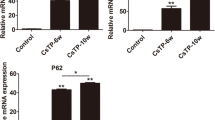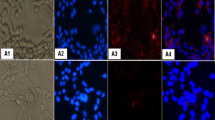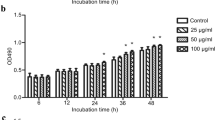Abstract
Clonorchiasis, caused by direct and continuous contact with Clonorchis sinensis, is associated with hepatobiliary damage, inflammation, periductal fibrosis, and the development of cholangiocarcinoma. Hepatic stellate cells respond to liver injury through production of proinflammatory mediators which drive fibrogenesis; however, their endogenous sources and pathophysiological roles in host cells were not determined. C. sinensis ferritin heavy chain (CsFHC) was previously confirmed as a component of excretory/secretory products and exhibited a number of extrahepatic immunomodulatory properties in various diseases. In this study, we investigated the expression pattern and biological role of CsFHC in C. sinensis. CsFHC was expressed throughout life stages of C. sinensis. More importantly, we found that treatment of human hepatic stellate cell line LX-2 with CsFHC triggered the production of free radicals via time-dependent activation of NADPH oxidase, xanthine oxidase, and inducible nitric oxide synthase. The increase in free radicals substantially promoted the degradation of cytosolic IκBα and nuclear translocation of NF-κB subunits (p65 and p50). CsFHC-induced NF-κB activation was markedly attenuated by preincubation with specific inhibitors of corresponding free radical-producing enzyme or the antioxidant. In addition, CsFHC induced an increased expression level of proinflammatory cytokines, IL-1β and IL-6, in NF-κB-dependent manner. Our results indicate that CsFHC-triggered free radical-mediated NF-κB signaling is an important factor in the chronic inflammation caused by C. sinensis infection.







Similar content being viewed by others
References
Asehnoune K, Strassheim D, Mitra S, Kim JY, Abraham E (2004) Involvement of reactive oxygen species in Toll-like receptor 4-dependent activation of NF-kappa B. J Immunol 172:2522–2529
Brigelius-Flohe R, Banning A, Kny M, Bol GF (2004) Redox events in interleukin-1 signaling. Arch Biochem Biophys 423:66–73
Chen T, Ning D, Sun H, Li R, Shang M, Li X, Wang X, Chen W, Liang C, Li W, Mao Q, Li Y, Deng C, Wang L, Wu Z, Huang Y, Xu J, Yu X (2014) Sequence analysis and molecular characterization of Clonorchis sinensis hexokinase, an unusual trimeric 50-kDa glucose-6-phosphate-sensitive allosteric enzyme. PLoS One 9:e107940
Cozzi A, Corsi B, Levi S, Santambrogio P, Albertini A, Arosio P (2000) Overexpression of wild type and mutated human ferritin H-chain in HeLa cells: in vivo role of ferritin ferroxidase activity. J Biol Chem 275:25122–25129
Elsharkawy AM, Mann DA (2007) Nuclear factor-kappaB and the hepatic inflammation-fibrosis-cancer axis. Hepatology 46:590–597
Friedman SL (2004) Mechanisms of disease: mechanisms of hepatic fibrosis and therapeutic implications. Nat Clin Pract Gastroenterol Hepatol 1:98–105
Friedman SL (2008) Mechanisms of hepatic fibrogenesis. Gastroenterology 134:1655–1669
Gloire G, Legrand-Poels S, Piette J (2006) NF-kappaB activation by reactive oxygen species: fifteen years later. Biochem Pharmacol 72:1493–1505
Hu F, Hu X, Ma C, Zhao J, Xu J, Yu X (2009) Molecular characterization of a novel Clonorchis sinensis secretory phospholipase A(2) and investigation of its potential contribution to hepatic fibrosis. Mol Biochem Parasitol 167:127–134
Huang Y, Li W, Huang L, Hu Y, Chen W, Wang X, Sun J, Liang C, Wu Z, Li X, Xu J, Yu X (2012) Identification and characterization of myophilin-like protein: a life stage and tissue-specific antigen of Clonorchis sinensis. Parasitol Res 111:1143–1150
Kim TY, Joo IJ, Kang SY, Cho SY, Hong SJ (2002) Paragonimus westermani: molecular cloning, expression, and characterization of a recombinant yolk ferritin. Exp Parasitol 102:194–200
Kim YJ, Choi MH, Hong ST, Bae YM (2008) Proliferative effects of excretory/secretory products from Clonorchis sinensis on the human epithelial cell line HEK293 via regulation of the transcription factor E2F1. Parasitol Res 102:411–417
Kim TI, Na BK, Hong SJ (2009) Functional genes and proteins of Clonorchis sinensis. Korean J Parasitol 47(Suppl):S59–S68
Levi S, Luzzago A, Cesareni G, Cozzi A, Franceschinelli F, Albertini A, Arosio P (1988) Mechanism of ferritin iron uptake: activity of the H-chain and deletion mapping of the ferro-oxidase site. A study of iron uptake and ferro-oxidase activity of human liver, recombinant H-chain ferritins, and of two H-chain deletion mutants. J Biol Chem 263:18086–18092
Liang P, Zhang F, Chen W, Hu X, Huang Y, Li S, Ren M, He L, Li R, Li X, Xu J, Wu Z, Lu G, Yu X (2013) Identification and biochemical characterization of adenylate kinase 1 from Clonorchis sinensis. Parasitol Res 112:1719–1727
Lim JH, Mairiang E, Ahn GH (2008) Biliary parasitic diseases including clonorchiasis, opisthorchiasis and fascioliasis. Abdom Imaging 33:157–165
Lv X, Chen W, Wang X, Li X, Sun J, Deng C, Men J, Tian Y, Zhou C, Lei H, Liang C, Yu X (2012) Molecular characterization and expression of a cysteine protease from Clonorchis sinensis and its application for serodiagnosis of clonorchiasis. Parasitol Res 110:2211–2219
Ma C, Hu X, Hu F, Li Y, Chen X, Zhou Z, Lu F, Xu J, Wu Z, Yu X (2007) Molecular characterization and serodiagnosis analysis of a novel lysophospholipase from Clonorchis sinensis. Parasitol Res 101:419–425
Morgan MJ, Liu ZG (2011) Crosstalk of reactive oxygen species and NF-kappaB signaling. Cell Res 21:103–115
Nam JH, Moon JH, Kim IK, Lee MR, Hong SJ, Ahn JH, Chung JW, Pak JH (2012) Free radicals enzymatically triggered by Clonorchis sinensis excretory-secretory products cause NF-kappaB-mediated inflammation in human cholangiocarcinoma cells. Int J Parasitol 42:103–113
Naugler WE, Karin M (2008) The wolf in sheep’s clothing: the role of interleukin-6 in immunity, inflammation and cancer. Trends Mol Med 14:109–119
Pantano C, Reynaert NL, van der Vliet A, Janssen-Heininger YM (2006) Redox-sensitive kinases of the nuclear factor-kappaB signaling pathway. Antioxid Redox Signal 8:1791–1806
Pfaffl MW (2001) A new mathematical model for relative quantification in real-time RT-PCR. Nucleic Acids Res 29:e45
Pinlaor S, Tada-Oikawa S, Hiraku Y, Pinlaor P, Ma N, Sithithaworn P, Kawanishi S (2005) Opisthorchis viverrini antigen induces the expression of Toll-like receptor 2 in macrophage RAW cell line. Int J Parasitol 35:591–596
Pinlaor S, Hiraku Y, Yongvanit P, Tada-Oikawa S, Ma N, Pinlaor P, Sithithaworn P, Sripa B, Murata M, Oikawa S, Kawanishi S (2006) iNOS-dependent DNA damage via NF-kappaB expression in hamsters infected with Opisthorchis viverrini and its suppression by the antihelminthic drug praziquantel. Int J Cancer 119:1067–1072
Recalcati S, Invernizzi P, Arosio P, Cairo G (2008) New functions for an iron storage protein: the role of ferritin in immunity and autoimmunity. J Autoimmun 30:84–89
Ribeiro M, Silva AC, Rodrigues J, Naia L, Rego AC (2013) Oxidizing effects of exogenous stressors in Huntington’s disease knock-in striatal cells—protective effect of cystamine and creatine. Toxicol Sci 136:487–499
Rim HJ (2005) Clonorchiasis: an update. J Helminthol 79:269–281
Serradell MC, Guasconi L, Cervi L, Chiapello LS, Masih DT (2007) Excretory-secretory products from Fasciola hepatica induce eosinophil apoptosis by a caspase-dependent mechanism. Vet Immunol Immunopathol 117:197–208
Serradell MC, Guasconi L, Masih DT (2009) Involvement of a mitochondrial pathway and key role of hydrogen peroxide during eosinophil apoptosis induced by excretory-secretory products from Fasciola hepatica. Mol Biochem Parasitol 163:95–106
Theil EC (1987) Ferritin: structure, gene regulation, and cellular function in animals, plants, and microorganisms. Annu Rev Biochem 56:289–315
Vennervald BJ, Polman K (2009) Helminths and malignancy. Parasite Immunol 31:686–696
Wang X, Chen W, Huang Y, Sun J, Men J, Liu H, Luo F, Guo L, Lv X, Deng C, Zhou C, Fan Y, Li X, Huang L, Hu Y, Liang C, Hu X, Xu J, Yu X (2011) The draft genome of the carcinogenic human liver fluke Clonorchis sinensis. Genome Biol 12(10):R107
Wang X, Chen W, Lv X, Tian Y, Men J, Zhang X, Lei H, Zhou C, Lu F, Liang C, Hu X, Xu J, Wu Z, Li X, Yu X (2012) Identification and characterization of paramyosin from cyst wall of metacercariae implicated protective efficacy against Clonorchis sinensis infection. PLoS One 7:e33703
Xiong J, Lu H, Lu K, Duan Y, An L, Zhu C (2009) Cadmium decreases crown root number by decreasing endogenous nitric oxide, which is indispensable for crown root primordia initiation in rice seedlings. Planta 230:599–610
Xu L, Hui AY, Albanis E, Arthur MJ, O’Byrne SM, Blaner WS, Mukherjee P, Friedman SL, Eng FJ (2005) Human hepatic stellate cell lines, LX-1 and LX-2: new tools for analysis of hepatic fibrosis. Gut 54:142–151
Yoon BI, Choi YK, Kim DY, Hyun BH, Joo KH, Rim HJ, Lee JH (2001) Infectivity and pathological changes in murine clonorchiasis: comparison in immunocompetent and immunodeficient mice. J Vet Med Sci 63:421–425
Zheng M, Hu K, Liu W, Hu X, Hu F, Huang L, Wang P, Hu Y, Huang Y, Li W, Liang C, Yin X, He Q, Yu X (2011) Proteomic analysis of excretory secretory products from Clonorchis sinensis adult worms: molecular characterization and serological reactivity of a excretory-secretory antigen-fructose-1,6-bisphosphatase. Parasitol Res 109:737–744
Acknowledgments
This work was supported by the National Key Basic Research and Development Project of China (973 project; no. 2010CB530000), National S & T Major Program (no. 2012ZX10004-220), National Natural Science Foundation of China (no. 81101270 and no. 81171602), Fundamental Research Funds for the Central Universities (no. 3164015).
Author information
Authors and Affiliations
Corresponding authors
Additional information
Qiang Mao and Zhizhi Xie contributed equally to this work.
Rights and permissions
About this article
Cite this article
Mao, Q., Xie, Z., Wang, X. et al. Clonorchis sinensis ferritin heavy chain triggers free radicals and mediates inflammation signaling in human hepatic stellate cells. Parasitol Res 114, 659–670 (2015). https://doi.org/10.1007/s00436-014-4230-0
Received:
Accepted:
Published:
Issue Date:
DOI: https://doi.org/10.1007/s00436-014-4230-0




